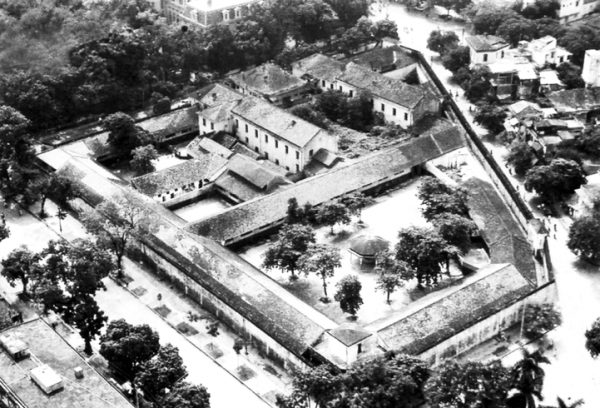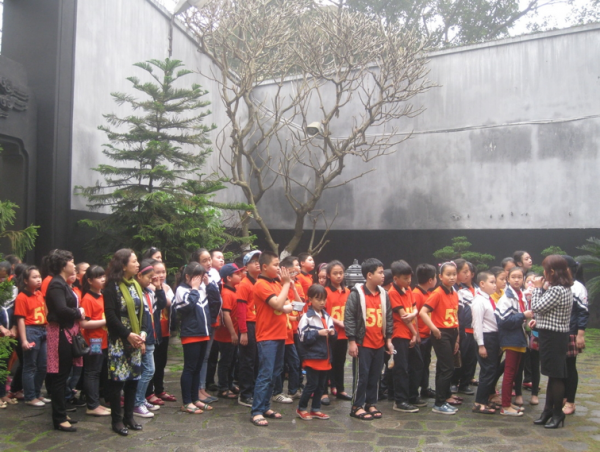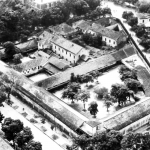A red address being located in the heart of Ha Noi Capital, is the evidence of crimes caused by the French colonialists, but also a place whereby patriotism and resilience of the Vietnamese people shed its light, that is the historical relic of Hoa Lo prison
The historic vestige of Hoa Lo prison nowadays is a remainder of the Southeast corner of the Central Prison of Ha Noi (La Prison Centrale de Ha Noi). This was once a huge prison built by the French colonialists in 1896 on the ground of Phu Khanh village, Vinh Xuong Hamlets, Tho Xuong District, Ha Noi. Phu Khanh used to be a craft village specialising in earthen family goods production which were fired in year-around burning ovens. This is a reason why the village was named as Hoa Lo, and this prison has been named after that.
In order to acquire an area of 12.908 square metres for the prison construction, the French colonial administration had displaced 48 households and demolished many religious architectures. Hoa Lo prison in conjunction with other institutions such as the Department of Secret police and the Crown Court had formed a tripod, the legal uninterrupted system, an efficient tool in service of the ruling regime of the French colonialists in suppressing struggle movements staged by the Vietnamese patriots.
Hoa Lo prison was seen as the most solid one in the Indochinese region, as that was built right at the centre of Ha Noi, metropolis of the French colonialist administration. The importance of the Hoa Lo prison was attached to its architectural designs, with very strong captivity rooms and surrounding walls as well as the best quality building materials. Though detention rooms, cells of Hoa Lo prison were differrent in size and function, but there were things in common that is cramped, lightless, stuffy and insanitary.

Overview of Hoa Lo Prison (1896 – 1954)
Having been captured under the most severe conditions at Hoa Lo prison, revolutionary fighters kept organizing a number of activities i.e learning, cultural and artist life. Particularly, they had staged various struggles to protest against the enemy’s detention policy, petitioning for the political prisoners’ rights,.. And above all, the fighters had turned “prison into revolutionary school”, a place for cultivating idealism, nurturing their revolutionary combatnesses.
It was right at this prison, the French colonialists had detained a great number of revolutionary firm and loyal soldiers, among them were five comrades as Nguyen Van Cu, Truong Chinh, Le Duan, Nguyen Van Linh, Do Muoi, all of them had become Secretary General of the Communist Party of Viet Nam afterwards. And apart for that, there were many other outstanding revolutionaries to be named Hoang Quoc Viet, Nguyen Duc Canh, Hoang Van Thu, Nguyen Luong Bang, Tran Dang Ninh,…
With their smartness and boldness, the revolitionaries captured in Hoa Lo prison had plotted lots of attempts to escape from the prison, especially the escape in December 1932 by 7 political prisoners from Phu Doan dispensary (current Viet Duc Hospital) and another escape of over 100 political prisoners in March 1945 either through undergound sewerage system or by climbing over the walls, or camouflaging to escape straight through the main gate; one more escape of 16 death sentenced prisoners by crawlling through the sewerage in December 1951. Successes of these escapes had contributed to reasserting unyieldingness and steadfastness of the Vietnamese revolutionary soldiers.
The Vietnamese people’s war of resistance against the French colonialists had gained complete victory in October 1954, it was also a time when the last revolutionary fighter detained at Hoa Lo prison had been released.
During 1964 to 1973, part of Hoa Lo prison was used by the Vietnam state to temporarily keep US pilots. Right here, the US pilots had been treated well in accordance with the international laws on war prisoners, demonstrating that the Vietnamese government had undertaken humanitarian and tolerant policy in favour of those even once were “as foes” of the Vietnamese people.
Until 1993, the government of Viet Nam had decided to convert the use purpose of Hoa Lo prison. The majority of its area was utilized for economic development and the rest area of 2.434 square metres was kept, renovated, embellished into a tourist educational attration in Ha Noi capital.
The installation of regular exhibits at Hoa Lo prison historic relic has clearly reflected its natures that: Hoa Lo prison is the site engraving atrocities committed by the French colonialists upon the Vietnamese people. It is the school to temper firmness and indomitableness of the revolutionaries. And nowadays, the historic vestige of Hoa Lo prison becomes an educational venue of patriotic tradtitions for generations of Viet Nam people, reminding them of upholding national pride and living a responsible life for the country.
At present, the historic relic of Hoa Lo prison is keeping partial original architectures and dozens of valuable objects such as guillotine to execute prisoners, underground sewerage entrance for prisoners’ escape, and many other valued documents. The number of visitors to the historic relic of Hoa Lo prison has been increasing continuously, especially in the last three years: 209.433 arrivals in 2013; 231.435 arrivals in 2014 and in 2015 249.192 arrivals.

Ha Noi students’ educational visit
At Historic relic of Hoa Lo Prison, March 2016
The historic relic of Hoa Lo prison has been becoming an attractive site for both domestic and international tourists, wishing to have deeper understanding of history of the Vietnamese people’s struggle for national defence.
Management Board of Historic Relic of Hoa Lo Prison

